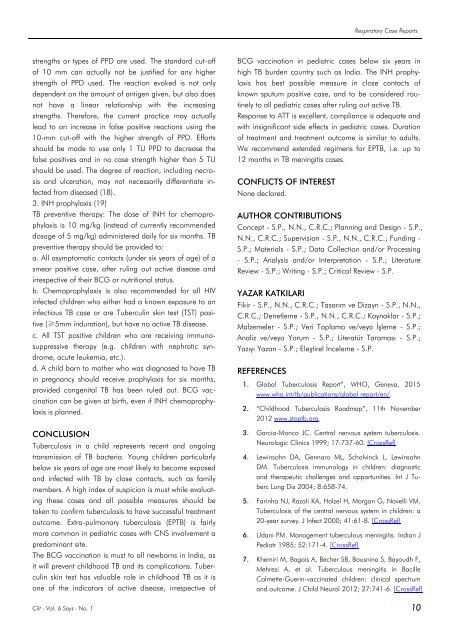Respircase Cilt: 6 - Sayı: 1 Yıl: 2017
Create successful ePaper yourself
Turn your PDF publications into a flip-book with our unique Google optimized e-Paper software.
Respiratory Case Reports<br />
strengths or types of PPD are used. The standard cut-off<br />
of 10 mm can actually not be justified for any higher<br />
strength of PPD used. The reaction evoked is not only<br />
dependent on the amount of antigen given, but also does<br />
not have a linear relationship with the increasing<br />
strengths. Therefore, the current practice may actually<br />
lead to an increase in false positive reactions using the<br />
10-mm cut-off with the higher strength of PPD. Efforts<br />
should be made to use only 1 TU PPD to decrease the<br />
false positives and in no case strength higher than 5 TU<br />
should be used. The degree of reaction, including necrosis<br />
and ulceration, may not necessarily differentiate infected<br />
from diseased (18).<br />
3. INH prophylaxis (19)<br />
TB preventive therapy: The dose of INH for chemoprophylaxis<br />
is 10 mg/kg (instead of currently recommended<br />
dosage of 5 mg/kg) administered daily for six months. TB<br />
preventive therapy should be provided to:<br />
a. All asymptomatic contacts (under six years of age) of a<br />
smear positive case, after ruling out active disease and<br />
irrespective of their BCG or nutritional status.<br />
b. Chemoprophylaxis is also recommended for all HIV<br />
infected children who either had a known exposure to an<br />
infectious TB case or are Tuberculin skin test (TST) positive<br />
(≥5mm induration), but have no active TB disease.<br />
c. All TST positive children who are receiving immunosuppressive<br />
therapy (e.g. children with nephrotic syndrome,<br />
acute leukemia, etc.).<br />
d. A child born to mother who was diagnosed to have TB<br />
in pregnancy should receive prophylaxis for six months,<br />
provided congenital TB has been ruled out. BCG vaccination<br />
can be given at birth, even if INH chemoprophylaxis<br />
is planned.<br />
CONCLUSION<br />
Tuberculosis in a child represents recent and ongoing<br />
transmission of TB bacteria. Young children particularly<br />
below six years of age are most likely to become exposed<br />
and infected with TB by close contacts, such as family<br />
members. A high index of suspicion is must while evaluating<br />
these cases and all possible measures should be<br />
taken to confirm tuberculosis to have successful treatment<br />
outcome. Extra-pulmonary tuberculosis (EPTB) is fairly<br />
more common in pediatric cases with CNS involvement a<br />
predominant site.<br />
The BCG vaccination is must to all newborns in India, as<br />
it will prevent childhood TB and its complications. Tuberculin<br />
skin test has valuable role in childhood TB as it is<br />
one of the indicators of active disease, irrespective of<br />
BCG vaccination in pediatric cases below six years in<br />
high TB burden country such as India. The INH prophylaxis<br />
has best possible measure in close contacts of<br />
known sputum positive case, and to be considered routinely<br />
to all pediatric cases after ruling out active TB.<br />
Response to ATT is excellent, compliance is adequate and<br />
with insignificant side effects in pediatric cases. Duration<br />
of treatment and treatment outcome is similar to adults.<br />
We recommend extended regimens for EPTB, i.e. up to<br />
12 months in TB meningitis cases.<br />
CONFLICTS OF INTEREST<br />
None declared.<br />
AUTHOR CONTRIBUTIONS<br />
Concept - S.P., N.N., C.R.C.; Planning and Design - S.P.,<br />
N.N., C.R.C.; Supervision - S.P., N.N., C.R.C.; Funding -<br />
S.P.; Materials - S.P.; Data Collection and/or Processing<br />
- S.P.; Analysis and/or Interpretation - S.P.; Literature<br />
Review - S.P.; Writing - S.P.; Critical Review - S.P.<br />
YAZAR KATKILARI<br />
Fikir - S.P., N.N., C.R.C.; Tasarım ve Dizayn - S.P., N.N.,<br />
C.R.C.; Denetleme - S.P., N.N., C.R.C.; Kaynaklar - S.P.;<br />
Malzemeler - S.P.; Veri Toplama ve/veya İşleme - S.P.;<br />
Analiz ve/veya Yorum - S.P.; Literatür Taraması - S.P.;<br />
Yazıyı Yazan - S.P.; Eleştirel İnceleme - S.P.<br />
REFERENCES<br />
1. Global Tuberculosis Report”, WHO, Geneva, 2015<br />
www.who.int/tb/publications/global report/en/.<br />
2. “Childhood Tuberculosis Roadmap”, 11th November<br />
2012 www.stoptb.org.<br />
3. Garcia-Monco JC. Central nervous system tuberculosis.<br />
Neurologic Clinics 1999; 17:737-60. [CrossRef]<br />
4. Lewinsohn DA, Gennaro ML, Scholvinck L, Lewinsohn<br />
DM. Tuberculosis immunology in children: diagnostic<br />
and therapeutic challenges and opportunities. Int J Tuberc<br />
Lung Dis 2004; 8:658-74.<br />
5. Farinha NJ, Razali KA, Holzel H, Morgan G, Novelli VM.<br />
Tuberculosis of the central nervous system in children: a<br />
20-year survey. J Infect 2000; 41:61-8. [CrossRef]<br />
6. Udani PM. Management tuberculous meningitis. Indian J<br />
Pediatr 1985; 52:171-4. [CrossRef]<br />
7. Khemiri M, Bagais A, Becher SB, Bousnina S, Bayoudh F,<br />
Mehrezi A, et al. Tuberculous meningitis in Bacille<br />
Calmette-Guerin-vaccinated children: clinical spectrum<br />
and outcome. J Child Neurol 2012; 27:741-6. [CrossRef]<br />
<strong>Cilt</strong> - Vol. 6 <strong>Sayı</strong> - No. 1 10

















